تتفشى متلازمة "كان من الممكن أن يكون هذا الاجتماع مجرد بريد إلكتروني" في عالم الأعمال. لا تصدق كلامنا - فالإحصائيات تتحدث بصوت أعلى من الكلمات:
- مسح شمل 182 من كبار المديرين أظهر أن 71% من المستجيبين وجدوا أن الاجتماعات غير فعالة وغير منتجة
- أكثر من نصف الموظفين يتحققون من رسائل البريد الإلكتروني أو الرسائل النصية أو يقومون بمهام متعددة أثناء الاجتماعات
- في المتوسط31 ساعة تضيع شهريًا في اجتماعات غير منتجة
على الجانب المشرق، تُعتبر الاجتماعات الدائمة أكثر فعالية من حيث الوقت من معظم لذا فإن تطبيقها طريقة ممتازة لتجنب الغفوة. 🥱
سيُعلمك هذا الدليل كيفية إجراء عمليات الوقوف اليومية القصيرة والرائعة التي تحافظ على تزامن فريقك دون استهلاك وقت العمل الثمين.
ما هو الاجتماع الاحتياطي؟
اجتماع المتابعة هو عبارة عن اجتماع قصير يتيح لك التواصل مع فريقك ومناقشة المهام المنجزة والقادمة إلى جانب أي تحديات. وقد شاعت هذه الطريقة من قبل تطوير البرمجيات الفرق التي تستخدم منهجية رشيقة -مجموعة من المشاريع مبادئ الإدارة تركز على التعاون متعدد الوظائف والنهج التكراري ل التحسين المستمر . 📈
تتم عمليات الوقوف عادةً بشكل يومي، على الرغم من أنه يمكنك تكييف الإيقاع لسير عملك. يمكن أن يستغرق الاجتماع ما بين خمس دقائق و15 دقيقة، وهو ما ينبغي أن يكون كافياً للانتهاء من الخطوات اللازمة بسرعة وفعالية.
كيف تدير اجتماعاً قائماً
إن الآلية التي تقوم عليها الاجتماعات اليومية بسيطة - تجمع فريقك وتدعهم يتناوبون على إجابة ثلاثة أسئلة:
- _ "ماذا فعلت بالأمس؟
- " "ماذا ستفعل اليوم؟
- _"هل هناك أي شيء يعيق تقدمك؟
هذه هي الطريقة المسماة "جولة روبن"، ولكن يمكنك أيضًا استخدام طريقة "السير على اللوح"، حيث يناقش الفريق بأكمله كل مهمة على اللوح بترتيب معين (عادةً من اليسار إلى اليمين).
فكر في الأسئلة المذكورة أعلاه كخطوات يجب على كل عضو من أعضاء الفريق أن يمر بها حتى يسفر الاجتماع عن النتائج المرجوة. دعنا نشرح كل منها بمزيد من التفصيل حتى تعرف ما الذي تبحث عنه في الإجابات.
السؤال 1: "ماذا فعلت بالأمس؟
يخدم هذا السؤال عدة أغراض مهمة إلى جانب السرد الواضح للمهام المنجزة. فهو يوضح ما إذا كان بإمكان عضو الفريق تحديد أولويات المهام الحساسة للوقت على تلك التي يمكن أن تنتظر، وهو أمر بالغ الأهمية في بيئة سريعة الإيقاع. 🏃
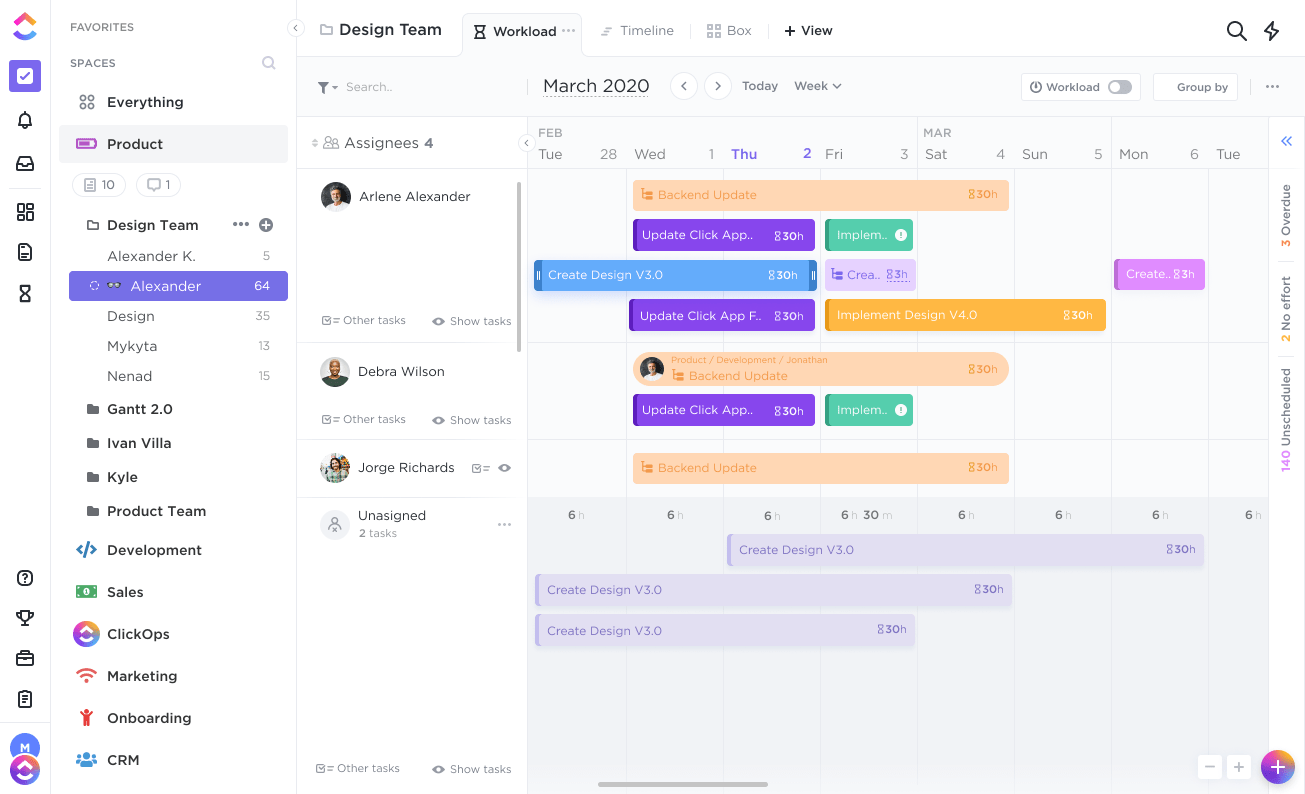
عرض أعباء عمل الفريق باستخدام عرض المخطط الزمني لتتبع التقدم المحرز وضبط تواريخ استحقاق المهام
في هذه المرحلة، يمكنك أيضًا إزالة أي أوجه قصور محتملة وأخطاء في التخطيط. على سبيل المثال، إذا قال أحد أعضاء الفريق أنه لم يقم بالكثير من المهام بينما كان عضو آخر مغمورًا بالمهام، فهذه علامة واضحة على ضرورة إعادة التوازن في سير العمل وإعادة ضبط عبء العمل وفقًا لذلك.
أخيراً، يمكن أن يساعد تبادل المعلومات حول المهام المنجزة فريقك على التعاون بشكل أكثر كفاءة والحصول على رؤى قيمة سيحتاجونها للعمل القادم.
قد يكون شخص ما قد أكمل مهمة مشابهة للمهمة التي سيعمل عليها عضو آخر في الفريق بعد ذلك، حتى يتمكن من تقديم يد المساعدة.
السؤال 2: "ماذا ستفعل اليوم؟
تتمثل إحدى النقاط الرئيسية للاستعداد اليومي في تحديد مسار اليوم التالي والتأكد من أن المهام القادمة تتماشى مع الهدف الشامل. تتيح لك هذه الخطوة القيام بشكل استباقي بتصفية الأعمال ذات القيمة المنخفضة وزيادة كفاءة فريقك.
لنفترض أنك اكتشفت ثغرة في المصادقة يجب تصحيحها بشكل عاجل. إذا قال أحد أعضاء فريقك إن خطته الأولية لهذا اليوم كانت إكمال مهمة أقل حساسية للوقت مثل إعادة هيكلة التعليمات البرمجية القديمة، فيمكنك أن تخبرهم أن يضعوا ذلك جانباً ويعملوا على المشكلة الأمنية.
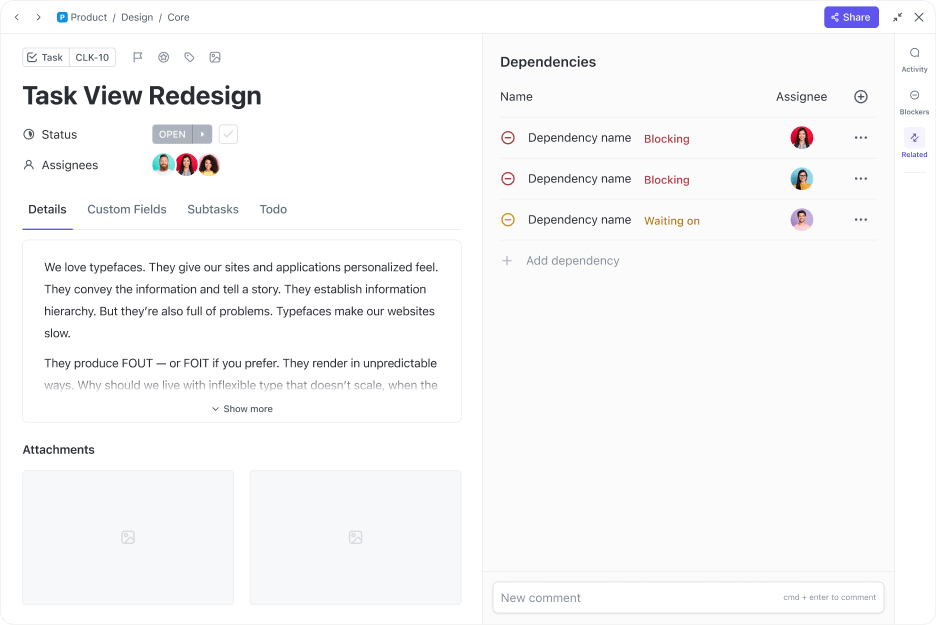
يمكنك عرض التبعيات أو إضافتها أو تعيينها أو التعليق عليها بسرعة مباشرةً في مهمة ClickUp
كما يمنع الحديث عن العمل القادم جميع أنواع سوء الفهم. فهو يزيل تداخل المهام, يوضح التبعيات ويضمن الاهتمام بالمهام الحرجة. ✅
السؤال 3: "هل هناك أي شيء يعيق تقدمك؟
تُخصص المرحلة الأخيرة من الاجتماعات التحضيرية لـ إزالة العوائق وإزالتها، مثل
- عدم تمكن أحد أعضاء الفريق من الوصول إلى المعلومات أو الأدوات التي يحتاجونها لإكمال مهامهم اليومية
- يجب أن ينتظروا انتهاء مهمة سابقة موكلة إلى شخص آخر
- تتطلب مهمة ما الموافقة عليها قبل إكمالها
شجع فريقك على أن يكون استباقيًا بشأن العوائق بحيث جميع الاتصالات اللازمة تحدث أثناء المتابعة. يساعدك هذا على تجنب الذهاب والإياب غير الضروري وعقد المزيد من الاجتماعات، مما يمهد الطريق لفريقك لتحقيق أهدافه. 🎯
6 نصائح لإدارة الاجتماعات اليومية الفعّالة أثناء الوقوف على أهبة الاستعداد
عند إدارة اجتماعات قصيرة مثل الاجتماعات القصيرة مثل الاجتماعات اليومية الجاهزة، يجب عليك جعل كل دقيقة مهمة . ⏱️
ستجد أدناه بعض النصائح القابلة للتنفيذ لتقليل الهدر وضمان حصول الجميع على قيمة من الاجتماع. ستتعلم أيضًا كيفية الارتقاء باجتماعاتك إلى المستوى التالي من خلال انقر فوق -منصة شاملة لإدارة المشاريع تلبي احتياجات فرق العمل الرشيقة من جميع الأحجام.
نصيحة 1: اجعل الأمر بسيطًا
يجب أن تكون عمليات الوقوف سريعة وديناميكية - اجمع الجميع في مكان واحد، واطلب منهم الإجابة على الأسئلة الرئيسية الثلاثة، ودعهم ينصرفون إلى عملهم اليومي. للبقاء رشيقًا، تمسكوا بـ عملية شفافة مقترنة بأداة أو أداتين بسيطتين لإدارة الاجتماعات.
ليس لديك وقت للتدقيق في المستندات أو جداول البيانات لضمان عدم تفويت أي شيء و تتبع تقدم المشروع -أنت بحاجة إلى محور مركزي لإبقاء المعلومات المهمة مرئية لأعضاء فريقك. انقر فوق الاجتماعات يتيح لك الاستمتاع بمثل هذا الوضوح وتقليل العمل اليدوي أثناء اجتماعاتك. يمكنك إنشاء قوائم مراجعة لكل عضو من أعضاء الفريق و تعيين التعليقات أثناء التنقل لضمان عدم إهمال التفاصيل المهمة.

تأكد من رؤية تعليقاتك من خلال تعيين تعليقات للمستخدمين مباشرةً في المهام، واحصل على عرض سريع للتعليقات المعينة في قائمة التحقق
يتيح لك خيار التحرير الغني للغاية في ClickUp تدوين ملاحظات الاجتماعات، وإبراز النقاط المهمة، وتضمين أنواع مختلفة من المحتوى للاحتفاظ بجميع الأفكار الرئيسية في مكان واحد. إذا كان سير عملك يتضمن مهام متكررة مثل تنقيح الأعمال المتراكمة ومراجعات التعليمات البرمجية، يمكنك جعلها متكررة بحيث تظهر تلقائيًا في قوائم الانتظار. 🔄
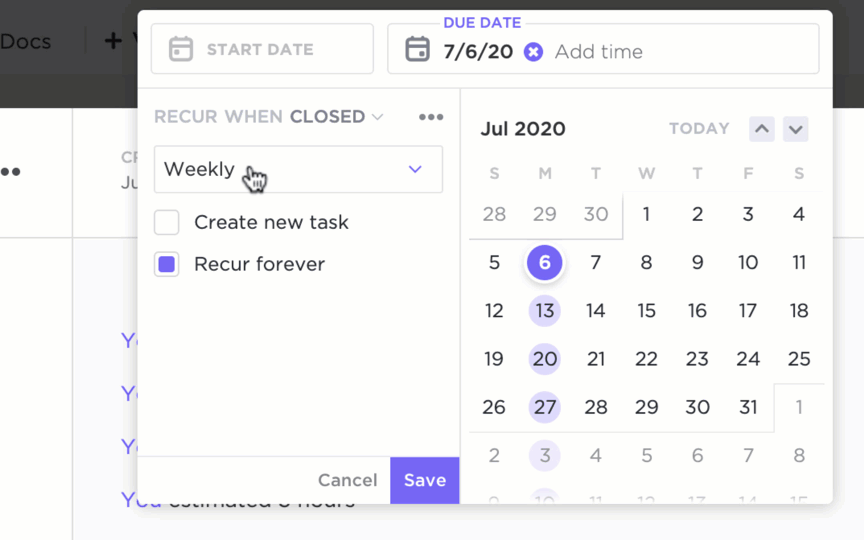
إعداد المهام المتكررة للتخلص من الأعمال المتكررة أثناء إنشاء جداول أعمال الاجتماعات
نصيحة 2: اختر وقتًا (والتزم به)
خصص وقتًا محددًا لاجتماعاتك واجعلها ثابتة. هذا يضمن لك التنظيم والقدرة على التنبؤ، مما يساعد فريقك على البقاء منظمًا ويحسن الحضور.
أما بالنسبة لـ متى يجب أن يعقد الاجتماع، فهذا يعتمد على سير عملك. من الناحية المثالية، ستقوم بإجراء اجتماع المتابعة في الصباح بحيث يكون فريقك جاهزًا لهذا اليوم بحلول الوقت الذي ينتهي فيه الاجتماع. ليس من الضروري أن يكون أول شيء تقوم به، ولكن تأكد من عقد الاجتماع قبل أن يكون فريقك جاهزًا للتشمير عن ساعديه.
القول أسهل من الفعل في الإعداد عن بُعد خاصة إذا كان أعضاء فريقك منتشرين على مستوى العالم. قد يكون صباحك صباح أحدهم، مما يعقد الأمور قليلاً.
إذا لم تتمكن من العثور على الوقت المناسب للجميع، فقد يكون الاجتماع في الوقت الفعلي هو خيارك الوحيد. إنها ليست فعالة مثل الاجتماع في الوقت الفعلي، لكنها لا تزال أفضل من ترك أحد أعضاء الفريق خارج الاجتماع تماماً.
نصيحة 3: احصل على نظرة عامة شاملة لجلسات الوقوف الخاصة بك
سواء كان فريقك في الموقع أو مختلطًا أو عن بُعد بالكامل، فإن آخر شيء تريده هو حفظ ما يحدث أثناء المتابعة - أو أن تتوقع من فريقك القيام بذلك. يجب أن يكون هناك أثر ورقي لكل ما تمت مناقشته لضمان بقاء الجميع على نفس الصفحة.
على أقل تقدير، ستحتاج إلى جدول بيانات لتتبع حضور كل عضو من أعضاء الفريق ومهامه وموانعه، وغيرها من المعلومات ذات الصلة.
في حين أنه لا يوجد خطأ في استخدام جدول البيانات الأساسي ، ستحتاج إلى حل أكثر قوة وبديهية لا يتطلب إنشاء نظام كامل من الصفر. إذا كنت بحاجة إلى مساعدة، فإن قالب اجتماع الاستعداد اليومي ClickUp يمكن أن يكون إضافة لا تقدر بثمن إلى اجتماعاتك.
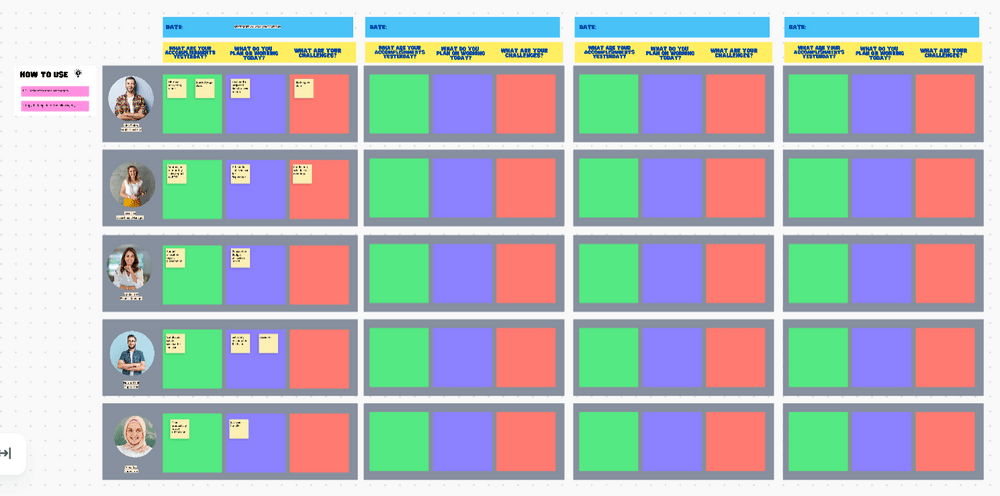
يتيح لك قالب الاجتماع اليومي ClickUp Daily Standup تنظيم اجتماعك بخيارات مثل الحالات المخصصة والحقول المخصصة وطرق العرض المخصصة
يأتي معبأ بكل ما تحتاجه لتنظيم اجتماعاتك والحفاظ عليها منظمة بدقة. يمكنك إدراج المهام مع الحالات المخصصة وتعيين تسميات الأولوية لتحديد تسلسل هرمي واضح ومعالجة الأعمال العاجلة على الفور. ⚡
أداة قوية عرض المجلس يتيح لك أخذ الحضور واطلع بوضوح على مهام كل عضو من أعضاء الفريق حتى تكون دائمًا على اطلاع على تقدم المشروع. شارك هذه النظرة العامة الشاملة مع فريقك، ولن تحتاج إلى القلق بشأن صوامع المشروع أو سوء الفهم.
يمكنك أيضًا تشجيع الفريق على ملء الحقول الخاصة بهم بشكل مستقل، وهو ما يحل إلى حد ما القيد المذكور أعلاه الخاص بالوقوف في مناطق زمنية مختلفة.
أخبر أولئك الذين لا يستطيعون الحضور أن يفعلوا ذلك بمجرد أن يبدأوا يومهم، وسيبقون على اطلاع دائم.
نصيحة 4: حافظ على قائد وهيكل واضحين
قبل أن تبدأ في إجراء المواقف، يجب عليك تعيين قائد يقوم بما يلي إنشاء جداول أعمال وإدارة الاجتماعات. إذا كنت تستخدم منهجية سكروم -مثل العديد من فرق العمل الرشيقة-سيكون هذا على الأرجح هو سيد سكروم .
إذا لم يكن كذلك، فيمكن أن يكون مدير منتج أو قائد آخر يعمل بصفة مماثلة.
أما بالنسبة لجدول الأعمال، فسيبدو عادةً على النحو التالي:
- كسر الجليد أو محادثة قصيرة غير رسمية لتهيئة الأجواء
- أسئلة الوقوف الثلاثة (إذا كنت تستخدم طريقة "راوند روبن")
- أي تحديثات متنوعة للمشروع
- الأهداف وعناصر العمل
بالطبع، هذا مجرد اقتراح، ولك الحرية في تنظيم الاجتماع بأي طريقة تناسب فريقك وسير العمل.
إذا كنت بحاجة إلى نظام أساسي لوضع جدول أعمال فعال، يمكنك استخدام مستندات ClickUp -آن أداة مدعومة بالذكاء الاصطناعي التي تمكنك من إنشاء جميع أنواع المستندات، بدءًا من ملاحظات الاجتماع إلى الويكي الشامل 📃
يأتي ClickUp Docs مع خيارات تخصيص وتنسيق لا حصر لها. يمكنك استخدام /أوامر النقر لإضافة كتل التعليمات البرمجية والأدوات والأزرار القابلة للنقر والعناصر التفاعلية الأخرى التي تساهم في جداول الأعمال الديناميكية.

استخدم أوامر الشرح المائل في مستندات ClickUp Docs لتنسيق جدول أعمالك وتحريره دون عناء
يتيح لك ClickUp Docs أيضًا تعيين عناصر الإجراءات، وتلخيص الاجتماعات، وإكمال العديد من المهام الأخرى، والتي يمكنك أتمتتها باستخدام ClickUp AI . إن أداة ذكاء اصطناعي قادرة يمكن أن تزيل الكثير من الأعمال الدنيوية من على عاتقك، مما يوفر المزيد من الوقت للتركيز على الاجتماع الفعلي.
النصيحة 5: استمر في التركيز على أهدافك
إن اجتماعات المتابعة الفعالة هي أكثر من مجرد مراجعة بسيطة - فهي تساعدك على تتبع أهدافك السريعة وتضمن عدم انحراف فريقك عن المسار الصحيح. يجب أن يخبرك كل اجتماع من اجتماعات المتابعة بمدى قربك من تحقيق الهدف وما إذا كان هناك أي شيء يمكنك القيام به من أجل تحسين سير عملك .
ولتحقيق ذلك، تحتاج إلى طريقة لعرض التقدم المحرز بما يتجاوز الأرقام الأولية وتحديثات الحالة. للحصول على نظرة عامة شاملة وجذابة بصريًا، يمكنك استخدام ClickUp Goals .
سواء كنت بحاجة إلى تتبّع نتائجك المضمونية (الأهداف والنتائج الرئيسية)، أو دورات السباق، أو أي أهداف محددة، يمنحك ClickUp Goals لوحة تحكم تفاعلية مقترنة بجميع الميزات التي تحتاجها للبقاء على اطلاع على تقدمك.
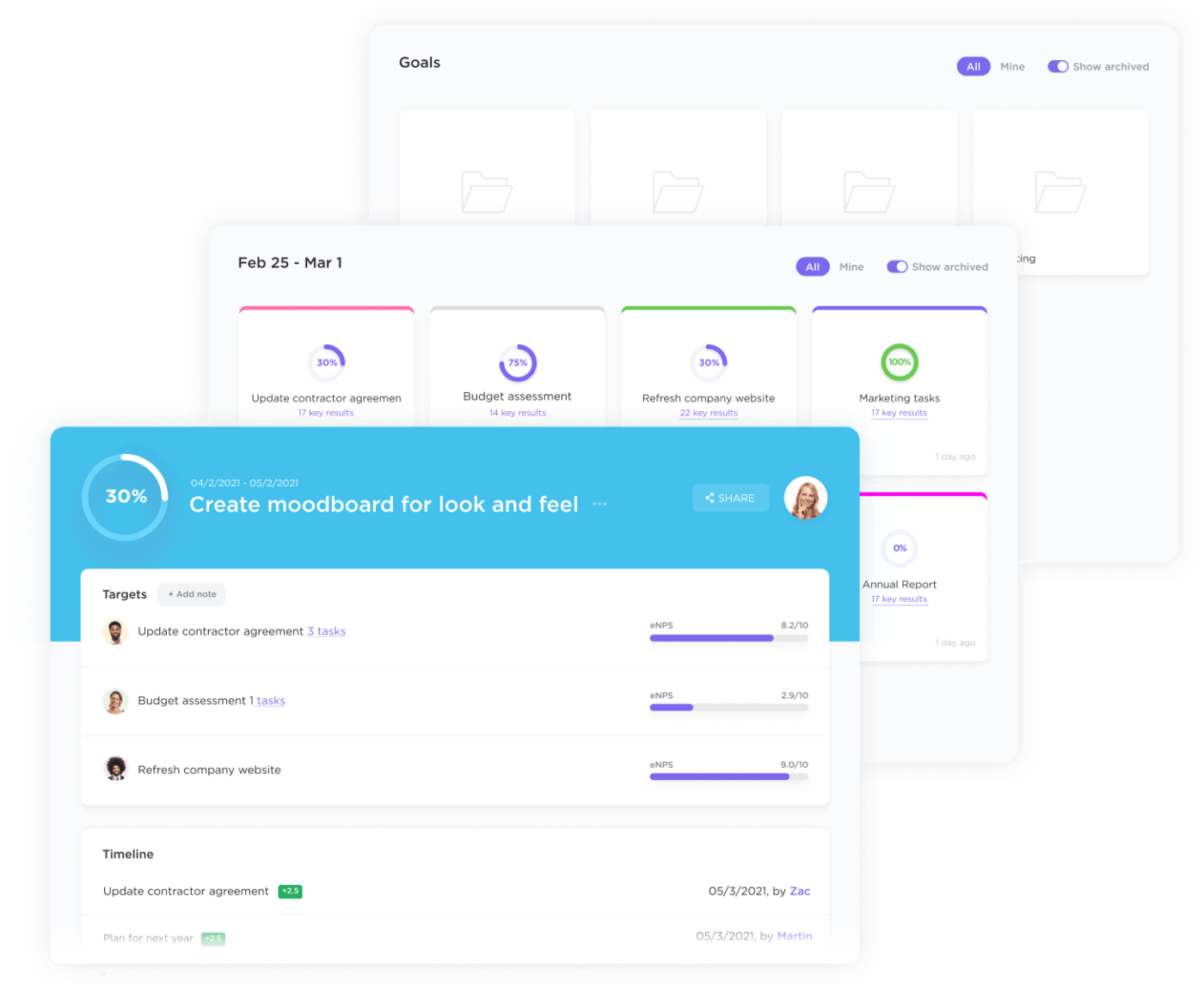
تتبّع دورات سباقات السرعة والمراحل الرئيسية والتقدم العام للمشروع بسهولة باستخدام ClickUp Goals.
على سبيل المثال، يمكنك ربط جميع المهام في سباق سريع بهدف واحد شامل، وسيمتلئ شريط التقدم تلقائيًا عندما يضع فريقك علامات على المهام على أنها مكتملة. يمكنك أيضًا إنشاء تجميعات التقدم ل المعالم الرئيسية ضمن الهدف والحصول على رؤية مفصلة عن آخر التحديثات. 🔔
مع أهداف ClickUp Goals، لا مجال للتخمين والارتباك. حدِّد أهدافك وعيّن المهام والمواعيد النهائية، وستحصل على فهم قوي لمهامك المتراكمة لضمان عدم خروجها عن السيطرة.
نصيحة 6: ضع دبوسًا في المشاكل المعقدة
_البارحة > اليوم > الحاصرات > تم!
هذا ما يجب أن تبدو عليه اجتماعات الوقوف - لا أكثر ولا أقل. ومع ذلك، قد تظهر الكثير من الموضوعات التي تتطلب المزيد من المناقشة. آخر شيء تريد القيام به هو الانغماس فيها، لأن القيام بذلك هو وسيلة مؤكدة لجعل الاجتماع يطول. 🐌
بدلاً من ذلك، ضع المشكلة على الرف وأخبر أحد أعضاء فريقك أنه يمكنك مناقشتها بشكل منفصل بمجرد انتهاء الاجتماع. وبهذه الطريقة، سيحصل الجميع على فرصة لمناقشة جميع الأسئلة الضرورية، وسيمضي الاجتماع بسرعة.
التحديات الشائعة في الوقوف على المنصة (وكيفية التغلب عليها)
حتى مع التخطيط والتنظيم الدقيق، قد لا تسير اجتماعاتك دائمًا بالطريقة التي تريدها. دعنا نتناول بعض المزالق الشائعة وتكتيكات التعامل معها. 💡
الحضور غير المنتظم
على الرغم من أنه من الطبيعي أن يتغيب أحد أعضاء الفريق عن الحضور في مناسبات نادرة إذا لم يكن متاحًا، إلا أنه لا ينبغي أن يصبح هذا أمرًا معتادًا. إنه يتعارض مع الغرض الوحيد من الاجتماعات اليومية، حيث لا يمكنك ضمان توافق فريقك دون الاطلاع على مهام الجميع والتقدم المحرز والعوائق المحتملة.
للتقليل من عدم الحضور، تأكد من أن فريقك يدرك أهمية الاجتماعات. قم بتوصيل قيمتها بوضوح، وأشر إلى أنها ليست سياسة مملة أخرى ولكنها شيء يفيد الفريق بشكل مباشر ويمكن أن يبسط سير عملهم.
إذا لم يفلح ذلك، يمكنك تحفيز فريقك من خلال تقديم المحفزات و/أو الروادع. ليس من الضروري أن يكون شيئًا مبالغًا فيه - فكر في شيء بسيط مثل جرة عدم الحضور أو مبلغ صغير رمز تقدير للحضور المنتظم 🎖️
عدم كفاءة الوقت
هناك العديد من الأسباب التي قد تجعل اجتماعاتك تستغرق وقتاً أطول مما هو مخطط له، وأبرزها
- يستغرق بعض أعضاء الفريق الكثير من الوقت
- هناك الكثير من التركيز على حل المشاكل
- أنت تستخدم طريقة غير فعالة في إدارة الاجتماعات أومنصة تواصل الفريق تجنب أو إصلاح مثل هذه المشاكل هي مسؤولية المنسق. يجب عليهم ألا يترددوا في منع أعضاء الفريق من التحدث إذا دخلوا في تفاصيل أكثر من اللازم وسلبوا وقت الآخرين. دع كل عضو من أعضاء الفريق يعلم أن لديه مقدارًا محددًا من الوقت للإجابة عن الأسئلة الضرورية وأن عليهم أن يكونوا موجزين. ⏲️
![]()
قم بإنشاء جداول زمنية لجمع وعرض الوقت المتتبع عبر المهام والمواقع للحصول على رؤى سريعة حول تقدمك
من المتوقع حدوث بعض الانحرافات عن الفترات الزمنية المخصصة في البداية، بينما لا يزال الفريق يعتاد على جلسات الوقوف. انتبه إلى الأسباب الرئيسية للهدر، وقم بضبط اجتماعاتك بمرور الوقت لإحكامها.
كتل التواصل
لا يشعر الجميع بالراحة في التحدث في مجموعة. هذا هو الحال بشكل خاص عندما يواجه أحد أعضاء الفريق صعوبة في إكمال مهمة ما، حيث قد يشعرون بالحرج أو يخشون أن يبدوا غير أكفاء إذا طلبوا المساعدة أو تحدثوا عن العوائق.
هناك عدة طرق للتعامل مع هذه المشكلة. يمكن أن تساعد كاسحات الجليد المذكورة أعلاه في تلطيف الأجواء وجعل أعضاء فريقك أكثر راحة. إذا لاحظت أن أيًا منهم لا يزال غير مرتاح، يمكنك أن تدعهم يتحدثون في النهاية حتى يتمكن الآخرون من ضبط الأجواء وجعل الأمر يبدو أقل صعوبة.
إذا لم تحصل على جميع التفاصيل التي تحتاجها، فاطلبها صراحةً من أجل حث عضو الفريق على التحدث. من خلال الممارسة والتكرار، يجب أن يجدوا سهولة أكبر في المساهمة ومشاركة جميع التحديثات ذات الصلة. 🗣️
انهض، قف!
يعد إتقان اجتماع الوقوف اليومي استثمارًا جديرًا بالاهتمام، حيث يمكن أن يؤدي إلى إحكام سير عملك وزيادة سرعة العمل للفريق بأكمله. كما يمكن للاجتماع الذي يتم تنفيذه بشكل جيد أن يشجع فريقك على الاستعداد لليوم التالي، مما يساعدهم على الحفاظ على إنتاجيتهم وتحفيزهم - حتى الاجتماع التالي. 🤩
كما رأيت، يمكن أن يساعدك ClickUp في جني هذه الفوائد من خلال مساعدتك في تنظيم وإدارة اجتماعاتك اليومية دون عناء.
إذا كنت ترغب في الاستفادة من ميزاته العديدة وضمان عدم إضاعة الوقت خلال اجتماعاتك, اشترك في ClickUp اليوم !

